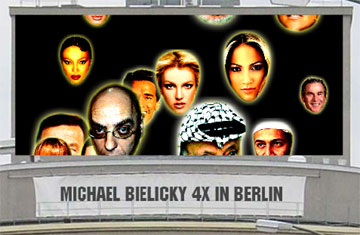As I’m thinking to swap Piedmondt’s agnolotti for Berlin’s Indian take-aways, I keep an eye on any news relating to the city. Here’s what I found today.
Media artist Michael Bielicky (also known for his installation “Menora”, at the Jewish Museum in Berlin) latest project, “Falling Stars” will open tomorrow on the facade of Berlin’s Theatre Volksbuhne. The video projection shows a constellation of the “stars” – from Hollywood actors to political icons and is part of a set of 4 installations of the artist in Berlin.

Via coin-operated.
Fourteen years after reunification, a survey found that a quarter of western Germans wish the 15 million east Germans were cut off again by the Berlin Wall, while 12 percent of eastern Germans wanted out of the united Germany.
Many westerners feel they have had to foot the bill for reunification — 24% said they had suffered financially as a result.
In the formerly communist east, which has twice the unemployment as in the west and where wages are still below western levels, one-third said they were no better off financially because of unification and the end of communism.
Because it is deemed both aesthetically out of fashion, and politically passé, the Bundestag voted to tear down the Palace of the Republic and erect a copy of a Baroque Hohenzollern palace in its place. However, plenty of people would like it to remain, at least until Berlin is better able to foot the bill for its demolition
![0,3772,16983_6,00[1].jpg](http://www.we-make-money-not-art.com/xxx/0,3772,16983_6,00%5B1%5D.jpg)
In few other cities does urban planning carry the same sort of baggage it does in Berlin, a city where architecture has a political dimension which ensures it’s regularly propelled into mainstream debate. In recent years, Berlin has been a battleground for conflicting architectural visions reflecting political agendas.
According to Dagmar Richter, a German-American architecture professor and critic, today’s architectural decisions are motivated first and foremost by a need actively to erase traces of East Germany. Since 1989, urban planners have been acutely aware that banishing the city’s communist -and fascist- legacy is a matter of both psychological and physical transformation.
This week opened in Leipzig “Two German Architectures”, an exhibition that illustrates that ultimately, East and West German architecture had more in common than might have been expected.
I am among those who found a certain charm in these “old-fashioned” and politically burdened buildings (I’m quite fond of the Milan train station*.)
From Deutsche Welle.
Designed by Graft, the new Q! hotel on Kurfürstendamm features an undulating interior. Continuous surfaces (where floors wrap up to become walls, seating areas, beds, counters and ceilings) are used throughout the hotel providing a “cocoonlike” effect.
![q_thumb[1].jpg](http://www.we-make-money-not-art.com/xxx/q_thumb%5B1%5D.jpg)
Can’t wait to have a peek when I’ll go to Transmediale , a festival for art and the creative use of digital media, in February.
Via Land+Living.
With the installation of the first base station in the Park Inn-Hotel at Alexanderplatz, Berlin now has DSL-to-go, a new service for road warriors who need broadband access wherever they are, without changing the provider and without reconfiguring the settings of their computer or PDA.
Related: The Automaten Bar.
*Should I precise that I’m not among the admirers of Benito Mussolini who can buy in some highway restaurants the T-shirts, statues, baseball bats staring Il Duce.
